Of Note
- Conservatory announces the David Boe Chair in Organ Studies
- Tribute Concert Honors the Memory of Wendell Logan
- Pianist George Li, Age 14, Wins 2010 Cooper International Competitions
- Oberlin at Oakton Series Marks 10th Anniversary
- Great Performances
- CD Recorded at Finney Garners NAACP Image Award Nomination
- Contemporary Music Ensemble Performs At Harvard University
- Student Composes Celebrity Walk-On Music for The Daily Show
- Oberlin Well Represented in YouTube Orchestra
- Student Spotlight
- Published Works
- Recordings
A Conservatory announces the
David Boe Chair in Organ Studies
The Conservatory of Music has established the first endowed professorship named for a current or emeritus professor—the David Boe Chair in Organ Studies—thanks to a $2 million gift from the Wyncote Foundation. The announcement was made during an organ alumni reunion weekend in March 2011 attended by more than 60 alumni spanning 50 years.
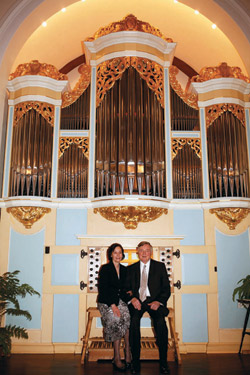
Sigrid and David Boe in front of the Boe organ at Peace Community
Church in Oberlin
(Photo by John Seyfried)
During the weekend of festivities, the college and community paid tribute to the many contributions of David and Sigrid Boe. David Boe was an inspiring teacher and performer and a very successful dean of the conservatory. Sigrid Boe is a pillar of the community, leading the way in civic endeavors ranging from the creation of the Splash Zone to the beautification of downtown Oberlin and the improvement of the city’s parks and recreation areas.
“It is especially fitting that this chair will be the first so named at the conservatory,” said Oberlin College President Marvin Krislov. “David Boe is a great man. He has meant so much to so many people, yet he retains deep humility and kindness. Sigrid and David truly are exemplary Oberlinians.”
At a ceremony that included tributes given by Dean of the Conservatory David H. Stull and many others, an organ was dedicated in the Boes’ honor at Peace Community Church in Oberlin. “We honor David Boe for his musical integrity, his advancement of the art form, and his devotion to teaching,” noted Stull.
The dedication ceremony, which coincided with David Boe’s 75th birthday, featured a concert by former students Mark Brombaugh ’68, James Russell Brown ’75, Jonathan Wessler ’06, William Peterson ’70, and Associate Professor of Organ Jack Mitchener.
The Peace Community Church organ is a gift of two anonymous donors who are former students of Boe. The 23-stop, two-manual and pedal organ was built in the style of the German organ builder Gottfried Silbermann (1683-1753) by the firm of Bozeman-Gibson in 1984 as their Opus 24 for the State University of New York, Stony Brook. It was later sold to Oberlin alumnus Ronald Gibson (’82 and ’07) in the late 1990s and restored in 2004 after a move to Rochester, N.Y. The two new reed stops on the organ were generous gifts from the Paul Fritts Organ Company of Tacoma, Wash., and the Flentrop Organ Company of Zaandam, Netherlands.
Concert Pays Tribute to Wendell Logan
When Wendell Logan arrived at Oberlin in 1973, jazz was little more than an extracurricular activity. Thirty-seven years later, the conservatory—which has offered a jazz performance major since 1989—unveiled the Bertram and Judith Kohl Building, the new home of jazz studies at Oberlin. This gigantic about-face owes largely to the influence of Logan, who recruited a world-class faculty and labored tirelessly to convince skeptics in the conservatory that jazz was a legitimate pedagogical pursuit.
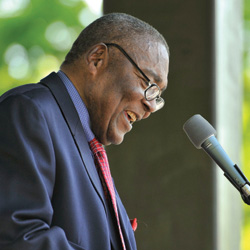
Wendell Logan
(Photo by Kevin Reeves)
Wendell Logan died on June 15, 2010, a mere six weeks after the opening of the Kohl Building. The sheer scope of his accomplishments at Oberlin, the innumerable musicians whose lives were enhanced by his wisdom and generosity, and his boundless love for the music made this loss all the more palpable. A musical tribute in honor of Logan was held October 9 in Finney Chapel. Fittingly, the event brought together the many exponents of Logan’s time at Oberlin: the first-rate jazz faculty, jazz alumni, and current jazz students.
The concert began with Logan's arrangement of "This Little Light of Mine," a bluesy, harmonically adventurous rendition sung by Andrew Frierson. Following that, the Oberlin jazz faculty performed three of Logan's compositions, including the funky "Shoo Fly" and the lush ballad "Remembrances," both of which the faculty recorded on the 2007 CD Beauty Surrounds Us.
Remarks and tributes were offered by Dean of the Conservatory David H. Stull, as well as by Johnny Coleman and Meredith Gadsby of the African American studies department, noted musician and author James McBride ’79, and Associate Professor of Jazz Guitar Bobby Ferrazza. President of the Alumni Association Dwan Robinson ’83 presented Logan with the Alumni Medal, inducting him into the Oberlin Alumni Association of African Ancestry Hall of Fame.
“Wendell’s consistent mentorship of and investment in our students has shown tremendous dividends through the quality of the alumni that we have seen,” said Stull after the concert. “He made a contribution that will impact generations of musicians and certainly all the members of the Oberlin community, and he will be greatly missed.”
"Whatever style or genre Wendell happened to be writing in, because he had a great depth of musical pallets to draw on, the music was always rich with emotion," said Ferrazza. "If one could borrow an over-used term: it is always soulful, Wendell's music."
The concert ended with a fiery, heartfelt performance by the Oberlin Jazz Ensemble (OJE), under the direction of Dennis Reynolds. The big band played Logan's arrangements of classic jazz standards like "Tin Tin Deo" by Dizzie Gillespie and Chano Pozo, and "Afro Blue" by John Coltrane. The audience, electrified by the vibrant and impassioned delivery of Logan's music by the students who had benefited so much from his teaching, gave the ensemble a standing ovation.
"Our performance in that concert was the best I've ever heard OJE sound, and the best big band performance I've ever been a part of," said saxophonist David Wise '11. "The faculty portion of the concert was amazing and awesome."
Tucked away at the end of the program notes for the evening was a quote from Bettye Logan that perhaps best summarized the sentiment following the concert. It read: "To his many students, we would like to say that it was through teaching that Wendell's greatest and most lasting gift was both given and received."
Pianist George Li, Age 14, Wins 2010
Cooper International Competitions
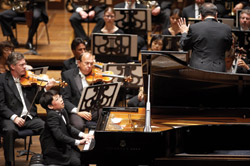
George Li at the 2010 Cooper Competition
(Photo by Roger Mastroianni)
George Li, a 14-year-old pianist from Lexington, Mass., won first-prize in the inaugural Thomas and Evon Cooper International Competition.
His stellar performance of Chopin’s Piano Concerto No. 1 in E Minor, Op. 11, with Jahja Ling conducting the Cleveland Orchestra in Severance Hall, brought him the top prize of $10,000, one of the largest awards offered by an international youth competition. The prize includes concert engagements with orchestras in Beijing and Shanghai, China, and a full, four-year scholarship to the Oberlin Conservatory of Music.
Full Oberlin scholarships were also awarded to the second- and third-place winners; John Chen, 14, of Leesburg, Va., won second prize and $6,000 for his performance of Tchaikovsky’s Piano Concerto No. 1 in B-flat Minor, Op. 23. Kate Liu, 16, of Chicago, won third prize and $3,000 for her performance of Prokofiev’s Piano Concerto No. 3 in C Major, Op. 26. The enthusiastic audience in Severance Hall gave each pianist a standing ovation.
Evon Cooper was one of the evening’s adjudicators, along with Gregory Allen ’70 of the University of Texas at Austin; Malcolm Bilson of Cornell University; Alan Chow of Northwestern University; Christopher Elton of the Royal Academy of Music; Stanislav Ioudenitch of the International Center for Music in Kansas; Matti Raekallio of the Juilliard School in New York and the Hochschule für Musik in Hanover, Germany; and Oberlin faculty members Angela Cheng, Sanford Margolis, Robert Shannon, director of the competition, and Haewon Song.
The Thomas and Evon Cooper International Competition is sponsored by the Oberlin Conservatory of Music and the Cleveland Orchestra.
Oberlin at Oakton Music Series Marks 10th Anniversary
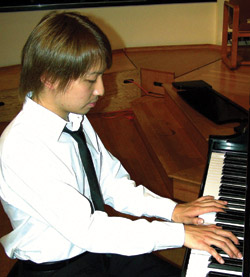
Yida Lin ’11 at the Oberlin
at Oakton concert
(Photo by Bruce Verner)
A little more than 10 years ago, Annabel S. Perlik ’49 and her late husband, longtime Oberlin trustee William R. Perlik ’48, were watching a string quartet of Oberlin students perform in the Washington, D.C. area. The performance was phenomenal, but the Perliks were concerned: the students were playing to a small audience. “Bill and I thought, ’We can help increase audience size,’” Annabel Perlik remembers. That year, the Perliks founded the Oberlin at Oakton Music Series, a yearly concert series showcasing Oberlin students and held in Oakton, Va.
Initially, the concert was held every January, scheduled to coincide with an annual Oberlin student string quartet performance at the Smithsonian Museum. “The series started with students performing at the Smithsonian one weekend and with us the other,” says Perlik. “But after the first year the conservatory students liked it so much that we added concerts in March and October, offering additional performance opportunities during spring and fall breaks.” The students are selected by recommendation of conservatory faculty; the January group is often a string quartet. Following each performance, the students field questions from the audience. “It allows us to hear more about Oberlin, and more about the students and their musical pursuits,” Perlik says. D.C.-area alumni regularly turn out for performances, and the concert is staffed and organized with the help of Oberlin alumni. Emceed by Stanley Richards ’58, the event is held at the church of the Oakton Unitarian Universalist Congregation of Fairfax, Va.
At Oberlin, students are given significant performance opportunities. The Oakton Series helps further develop Oberlin’s reputation and enhances its mission to provide excellent musical education. “The experience our students gain by performing in alternative venues is invaluable to their professional training,” says Dean of the Conservatory David H. Stull. “We are grateful to Mrs. Perlik for her continuous support of the Oakton Concert Series and for her dedication to furthering the careers of our student musicians.”
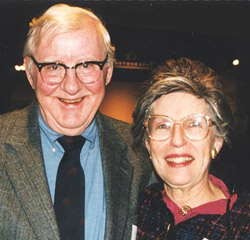
Bill and Annabel Perlik
“It’s always nice for [students] to move out of their comfort zone in Oberlin and play elsewhere,” Perlik agrees. “People who attend the concerts love them so much. They are awed by the artistic excellence; and best of all, it’s free!”
Being selected to perform in the Oakton Series is an honor in itself, and many of the student performers go on to have distinguished careers as performers and teachers. For instance, pianist Yuri Shadrin ’05, who performed in 2004, now studies at Peabody Conservatory with Leon Fleisher. In spring 2010, pianist Yida Lin ’11 performed a solo piano recital; that fall, he went on to win the Oberlin Conservatory Concerto Competition. The Prima Trio performed at Oakton in 2005; in 2007, they were the Grand Prize and the Gold Medal winners of the prestigious Fischoff National Chamber Music Competition. The distinguished Jasper String Quartet also performed at Oakton years ago. After Oakton, they went on to win the Grand Prize and the Audience Prize in the 2008 Plowman Chamber Music Competition, Grand Prize at the 2008 Coleman Competition, First Prize at Chamber Music Yellow Springs 2008, and the Silver Medal at the 2008 and 2009 Fischoff Chamber Music Competitions. “We were just one of the stops on their way,” Perlik says. “It’s been our privilege to get to know all of the students who have performed for us.”
William Perlik, who passed away in 2006, is memorialized also on the Oberlin campus. The Science Center's Perlik Commons is a tribute to his steadfast dedication to the advancement of Oberlin College.
Great Performances
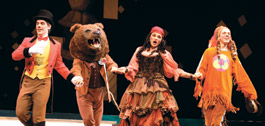
The Bartered Bride, Matthew Brewer, Miguel Amaguaña, Cree Carrico, and Eric Fischer
Oberlin Opera Theater presented two exhilarating productions this year. The Bartered Bride, a three-act comic opera by Czech composer Bedrich Smetana, with libretto by Karel Sabina, was staged in November. Jonathon Field, associate professor of opera theater, served as director, with Christopher Larkin guest conducting the Oberlin Chamber Orchestra. The production featured traditional Czech choreography and costuming framed within a Chagall-inspired set. Set in a country village, The Bartered Bride tells the story of "an arranged marriage, rearranged by a pair of determined lovers," says Field, who visited the Smetana Museum in Prague to make sure all aspects were authentically "rooted in Czech soil. This is a Czech version of Porgy and Bess—detailing specific people in a specific time and place."
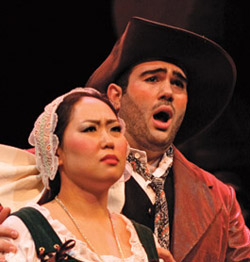
Hyewon Kwon and Roy Hage
Mozart’s La Clemenza di Tito, set to the composer’s ravishing score, was presented in March 2011. Internationally known as an expert in Italian singing style and tradition, Danish conductor and pianist Niels Muus served as guest conductor. Field once again directed. The plot involves the scheming Vitellia, who is planning to overthrow the emperor Tito, who seized the throne from her father—yet is also her unrequited love. Traditionally set in ancient Rome, Field looked to the present for this production, plus used females in some male roles. “We avoided the ’toga look’ that has weighed down the opera for years and tried to stress the universality of the piece, with references to the original,” says Field. “The atmosphere is shifted from one of public formality to private emotions.”
Clemenza is a challenging production, musically and artistically, for everyone involved. “This was the first time I did this production with such a young cast and orchestra,” says Muus. “The only place this would be possible is the Oberlin conservatory.”
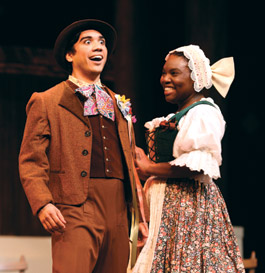
Miguel Amaguaña and Chabrelle Williams. La Clemenza di Tito
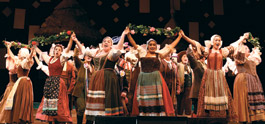
Cast members perform a Czech dance
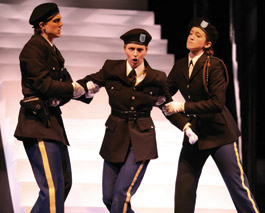
Julia Dawson (center) with Robert McGinniss and Kelsey Robertson
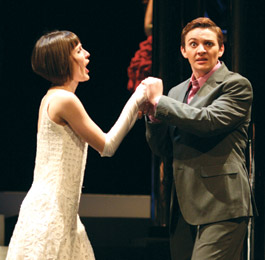
Adrienne Sereta and Grace Newberry
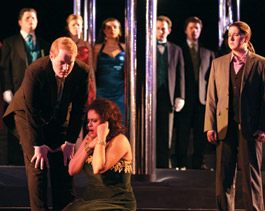
George Somerville, Summer Hassan, and Danielle Lombardi
CD Recorded at Finney Garners
NAACP Image Award Nomination

Parts of Allen’s CD were recorded
live at Oberlin.
Internationally acclaimed jazz pianist Geri Allen’s newest CD, half of which was recorded at a live concert in Finney Chapel, was nominated for a 2011 NAACP Image Award in the category of “Outstanding Jazz Album.” The CD, Geri Allen & Timeline Live, features drummer Kassa Overall ’06, as well as veteran bassist Kenny Davis and tap dancer Maurice Chestnut, in a nod to the tight-knit relationship between early jazz and dance. The Oberlin portion of the CD was engineered by Director of Conservatory Audio Services Paul Eachus.
Critical response to the album has been overwhelmingly strong. The New York Times hailed it as “a rewardingly bold new statement” from “a wise and dynamic pianist” and “her sharp young working band.” And All About Jazz singled out Overall as an “exciting young drummer,” and wrote that the musicians “evoke images that are imaginative and compelling.”
The CD includes mainly compositions by Allen, many of which deliberately reference the rhythms of tap and mid-century swing and bebop music.
Other nominees in the category of Outstanding Jazz Album this year were Herbie Hancock, Dee Dee Bridgewater, Wynton Marsalis, and Bobby McFerrin.
Contemporary Music Ensemble Performs
At Harvard University
Oberlin’s Contemporary Music Ensemble (CME), under the direction of Timothy Weiss, conductor, performed two concerts of 20th- and 21st-century music at Harvard University’s John Knowles Paine Concert Hall in April. The concert series, titled Interior Gardens, was curated by Chaya Czernowin, Walter Bigelow Rosen Professor of Composition at Harvard, and also featured performances by the noted German contemporary music group, Ensemble SurPlus.
Czernowin was a guest at Oberlin in fall 2009, during which time the CME performed her string octet, Anea Crystal. Weiss, who conducted the performance, says, “Czernowin was so taken by the quality of the players, the quality of the group, their commitment to playing new music, and making their own decisions on how they wanted a piece to be performed, that she invited the group to present a concert at Harvard.
“It’s great for us because it gives us recognition of the commitment that we make to new music, and the detail and beauty with which we perform it,” continues Weiss. “It’s a wonderful honor for us.”
Works performed by CME included Wheel of Emptiness by Jonathan Harvey; Immeasurable Space of Tones by John Luther Adams; Clear Sky by Josh Levine, assistant professor of composition at Oberlin; Harrison Birtwistle’s Silbury Air; and Rebecca Saunders’ Disclosure.
Student Composes Celebrity Walk-On Music
for The Daily Show
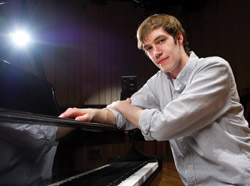
Ryan Lester ’11 wrote the celebrity walk-on music used during the third act of
The Daily Show.
Oberlin students and alumni have, from time to time, wound up on The Daily Show with Jon Stewart: actor Ed Helms ’96 was a correspondent for five years, author Ishmael Beah ’04 was invited for an interview, and activist Kalan Sherrard ’10 was famously featured as Jon Stewart’s “moment of zen” after parading around in a cow costume at a political rally. Composer and May 2011 graduate Ryan Lester contributed to the show in a different way: by writing the celebrity walk-on music used during the show’s third act.
“They wanted six pieces,” says Lester. “Three ’celebrity’ walk-ons and three ’political’ walk-ons in four- and 10-second cuts. There was no required theme. In fact they specifically wanted it not to be a variation on The Daily Show theme song.”
Lester’s path to composing for The Daily Show involved a chain of winter-term and summer internships. He met Justin Melkmann, music producer for The Daily Show, during his first-year winter term. Melkmann then introduced him to Jon Spurn, who regularly composes for The Daily Show and The Colbert Report. “From Jon, I learned about the nature of being a commercial composer and how to interpret what a director or commercial agent wants,” says Lester. He kept his Daily Show contacts and spent the following summer interning at JSM Music in New York, the largest commercial music house in the United States. Lester then created a demo reel of his commercial music and sent it to Melkmann, who was so impressed that he hired Lester to compose for The Daily Show.
Although he had free reign to use whatever thematic material he wanted, Lester had to anticipate what the show’s producers were envisioning for the celebrity walk-on music. “For the political tracks, I interpreted that as more of an NBC or CBS news feel and wrote some quasi-orchestral tracks,” he says. “The first celebrity walk-on I did was a funk track. I had a bass player record the bass line, and I played organ, guitar, and trombone.
“For the last celebrity walk-on,” he adds, “they wanted music similar to the Academy Awards, but with modern instruments. This was tricky, because the music from the Academy Awards is one large orchestral chord that’s richly orchestrated, and which wouldn’t work at all for modern instruments.” Nevertheless, Lester adapted the soaring style of the award show’s music. “I gave a lyrical line to the electric guitar that would have normally been played by the violins, and I gave the typical cadential timpani motive to the electric bass to suggest the pomp of the Academy Awards without the instrumentation.”
Lester has been accepted into New York University’s film scoring program, but he’s also considering returning to the commercial music houses where he interned. He also composes for film and video games.
Oberlin Well Represented in YouTube Orchestra
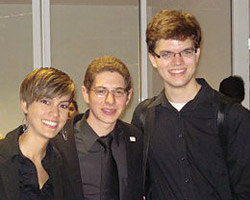
Xiomara Mass ’10, Matthew Berliner ’11, and D.J. Cheek ’12 were selected for the 2011 YouTube Symphony Orchestra, whose March performance in Sydney, Australia, was live-streamed on YouTube.
Three Conservatory of Music students had the chance in March to participate in something vastly different from traditional classical performance opportunities: the 2011 YouTube Symphony Orchestra.
Matthew Berliner ’11, a double-degree French horn player from Seattle; Dillard (D.J.) Cheek ’12, a violist from Easley, S.C.; and Xiomara Mass ’10, an oboist from Bayamon, Puerto Rico, pursuing an Artist Diploma degree, were drawn to the orchestra for the chance to travel to Australia, play in the Sydney Opera House, and work with renowned conductor Michael Tilson Thomas, founder and artistic director of the New World Symphony.
Applicants for orchestra spots made an audition video and posted it to YouTube. A group of professional musicians then chose the finalists from the submissions, and YouTube visitors voted to select the final orchestra.
In Australia, the Oberlin students joined 98 other musicians from 33 countries for a week of practicing, learning, and performing before the final concert on March 20. Berliner says the event’s organizers brought in “great orchestral musicians” as coaches, which ultimately led them to learn quickly and work hard.
The atmosphere, while intense with long days of rehearsal, was nevertheless exciting. Cheek says he was surprised “by how energetic, enthusiastic, and committed everyone was. Everyone wanted to be there.”
For the final concert, which was live-streamed on YouTube, the Sydney Opera House projected a light show both inside and on the outside “sails” that make up the building’s roof. Mass says there were 30.7 million streams on computers alone, and Berliner says the live-stream numbers “beat U2.” Berliner declared proudly, “Classical music beat out pop music!”
Berliner thinks this predicts huge things for the future of classical music. “This opens up possibilities for classical music and symphonies in the digital age. People are genuinely interested; this is no fluke.”
Riding the technologically triumphant coattails of the 2011 YouTube Symphony, viola student Cheek travelled to London on May 13 to take part in a performance at Google’s 2011 European Zeitgeist. The annual forum convenes hundreds of the world’s leading thinkers to discuss topics that influence the global economy, creativity, digital technology, leadership, and human rights.
Student Spotlight
• TIMARA student Calder Kusmierski Singer ’11 composed the score for Jack Ferver’s Rumble Ghost, a theater and dance performance that reinterprets the 1982 horror film Poltergeist. Rumble Ghost was performed in December at Performance Space 122 in Manhattan. The New York Times called it “darkly funny” and singled out Singer’s “ominous score.” “Ultimately I wrote what I wrote,” said Singer, “and as we went along I kept tailoring the tracks down to fit what Ferver wanted. Music is rather present in the piece, so it was a great experience (and a lot of work). I can’t stress enough that it was lucky my music fit his style.” Of Singer’s score, Ferver wrote: “As a group we really started the heavy lifting in August. That lifting also included Calder Kusmierski Singer, who wrote that maniacally perfect score.”
• Caeli et Terrae, a composition by Jake Market ’12, was performed in Cleveland’s Severance Hall in January. The piece, written for high school and college musicians, was hosted by the Cleveland Youth Wind Symphony and the Case [Western Reserve University] Symphonic Winds. Market’s piece was programmed at the recommendation of David Eddleman, director of the symphonic band at Avon Lake High School near Cleveland. “Most of us grew up in a public school system in which we played the same music over and over,” he says. “I’m not saying it wasn’t good music, just that I became bored with the same style and goals these composers seemed to seek. For a high school student who sits in band, choir, or orchestra every day, those pieces all mush together. I wanted to give them something completely different.”
• Of the students who spend part of their junior year abroad, few tour Europe playing dance music. In 2009, TIMARA major Logan Takahashi ’11 and Nick Weiss ’11 did exactly that, setting up shop in Amsterdam and performing under the moniker Teengirl Fantasy. Since returning to the U.S., the two have continued touring the country, produced a song with rap group Das Racist, and released an LP on True Panther Records. That album, 7 a.m., earned universal praise from music blogs and newspapers ranging from the Guardian to the Village Voice, and was featured on Best of 2010 lists from taste-making music blogs Pitchfork and Stereogum.
Published Works
• The Golden Age of Conductors, by Professor of Music Education John W. Knight, was published this year by Meredith Music Publications. The book is a compilation of articles Knight wrote for The Instrumentalist magazine; in all, there are essays on 21 conductors, as well as interviews Knight held with five conductors and two orchestral players. The book also includes a chapter on the history of conducting and one on American orchestras. Leon J. Bly, writing for the World Association for Symphonic Bands and Ensembles, praised the book. “This is the kind of inspirational book that helps one to grow as a conductor,” Bly wrote. Knight “writes very well and never gets bogged down in minutiae…. It is a book that belongs in every serious conductor’s library.”
• During 2009-10, Associate Professor of Musicology Charles Edward McGuire ’92 completed his book Music and Victorian Philanthropy: The Tonic Sol-fa Movement (Cambridge University Press, 2009). The monograph examines a method of sight-singing notation used in the 19th century throughout Great Britain and its empire, and how that notation became enmeshed in the charity, politics, and morality of the day. A review of the book in Victorian Studies noted “Music and Victorian Philanthropy is full of wonderfully chosen and beautifully described highways and byways of unknown musical Britain.”
Recordings
• In addition to her usual Smithsonian series with the Axelrod String Quartet, Professor of Violin Marilyn McDonald released three new CDs this past year. She released a CD of Mozart chamber music on Virgin Classics, performed Haydn’s String Quartets Op. 9 and Op. 17 for the Dorian label, and, with the Castle Trio, released Piano Trios of Clara and Robert Schumann on Smithsonian Recordings.
• Bridge Records released a CD of works by former Professor of Composition Arlene Zallman. Zallman passed away in 2006 after a long tenure at Wellesley College. The CD is the first recording devoted to her works. Composer Martin Boykan writes: “Zallman never repeated herself, and her technical range is considerable. I hope this CD will stimulate interest in an oeuvre that occupies a distinguished position in the music of our time.”
